Whether you’ve been to Europe before or not, sometimes you might find yourself with plenty of time but not plenty of money. If you’ve got at least two weeks and hopefully closer to four weeks, you can still have an amazing experience in some of Europe’s greatest cities on a small budget. If you’ve visited London, Paris, or Rome before, you’ll be happy to know that you can visit many other cities while spending half or even less per day.
The itinerary suggestions below are perfect for two quick weeks. If you have more time this is still a great itinerary to use as a starting place, and you’ll find other places you’ll want to add along the way if you have more time. We use our Europe Backpacker Index to show the price comparisons of the cities suggested. Each of those prices is a typical day’s expenses for someone on a ‘backpacker’ budget. If you prefer 3-star hotels you’ll spend at least a bit more per day, but if you are sharing a cheaper hotel room it can still be shockingly inexpensive. By the way, for your first trip to Europe you probably want to choose England, France, or Italy, and save the cheap ones for your next trip.
Note: This article was last updated in August, 2022.
Best four cheap European cities to visit together
- Berlin, Germany
- Prague, Czech Republic
- Budapest, Hungary
- Krakow, Poland
Each of the cities listed above is strong enough to be the highlight of almost any trip, and fortunately they are relatively close together so they work really well as a group. On the map they sort of form a box, so skipping one is easy, and there are plenty of side stops and trips possible in between for shorter or longer stays.
A version of this itinerary can also be found on my new best Europe itineraries for first-time visitors article.
Best cheap and gorgeous small town to add to your trip
- Český Krumlov, Czech Republic
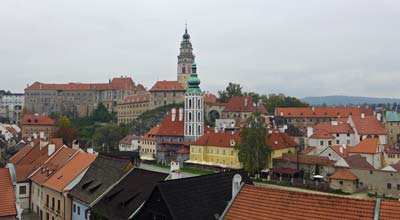
Getting there and back
While none of these cities is among the cheapest in Europe to fly into, at least 3 of them have cheap enough flights that it’s worth flying directly into one of them.
Of the four cities, Berlin will have the cheapest inbound flights from almost anywhere, and Krakow usually only has cheap flights from within Europe. Check flights from your city into each of these cities to see which one will be your cheapest option.
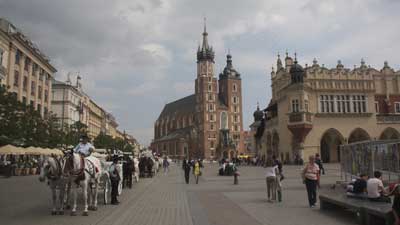
Getting between the cities
There’s little doubt that the most enjoyable way to get between these cities (and most European cities) is by train, but you do have two other main options to consider, namely, flights and buses.
Trains
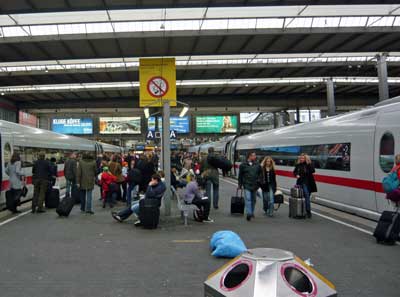
Flights
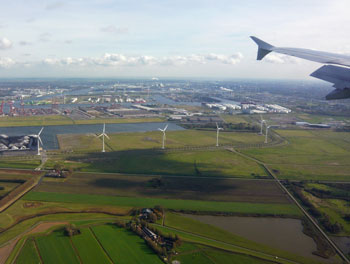
Buses
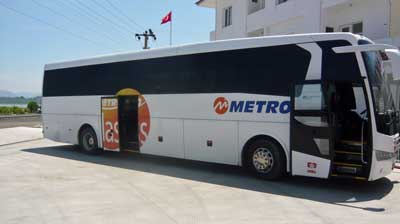
4 Best cheap European cities that are easy to travel between
Below you’ll find the four best cities to use as the foundation of a cheap and wonderful trip to Europe. It’s recommended to spend at least 3 nights in each city, even if you think you are in a hurry.
Berlin, Germany
2022 Backpacker Index: US$64.56/day
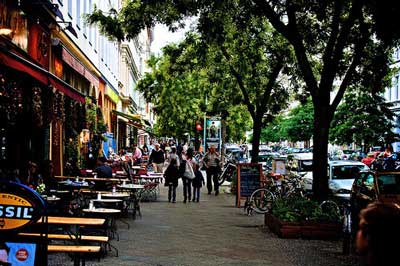
One challenge is that Berlin is a huge and spread-out city, so it’s important to choose where you stay wisely. Most budget travelers will prefer the former East Berlin section around Mitte and Prenzlauer Berg, which is where most hostels are as well as the best and cheapest nightlife and shopping. Check our list of recommended cheap Berlin hotels for a place to start.
What to see and do in Berlin
Start with the Berlin Free Walking Tour on your first morning, and you’ll have enough ideas for what to do for the rest of your stay from that alone. Being honest, the Reichstag (capital building) is a bit disappointing from the inside, although the city does have a handful of great museums clustered together that appeal to many. The Berliner Dom (cathedral) is well worth a visit and you’ll get some great photos from out front.
But mainly Berlin is about exploring the weird and funky neighborhoods for food, shopping, and nightlife. Fortunately, most of it is quite cheap as well. Probably the most famous food to try is currywurst, which is usually a paper tray containing a sliced up hot dog coated in a curry-flavored ketchup. I’m not really a fan, but you should try it, especially after a few beers.
Prague, Czechia
2022 Backpacker Index: US$53.95/day
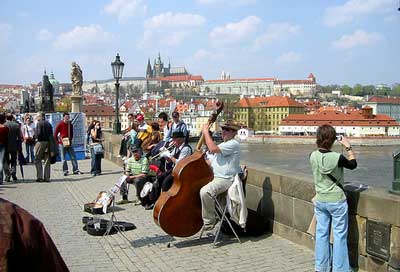
Prague is also fairly compact, with most things walking distance from each other. The city is also quite cheap still, at least compared to Western Europe, although hotel prices can seem high if you want to stay in the middle. Check our list of recommended cheap Prague hotels for some really good ones only a quick and cheap tram ride away.
What to see and do in Prague
Aside from the famous clock in the town square, Prague has a few other very worthwhile checklist attractions. The Prague Castle is one of the largest and most incredible in Europe, and the Charles Bridge and its statues feels like you should have to pay to cross it. As with most European cities, it’s wise to start with a “free” (tips-based) walking tour on your first morning in town. The Prague ones are excellent and in a couple hours you will have seen most of the famous landmarks while hearing the interesting stories behind them. Even a US$10 equivalent tip per person is a great bargain, but tip whatever you feel good about.
There is plenty more to fill a few days, plus you can catch a cheap classical concert in one of the many venues offering them, or just indulge in cheap and excellent beer like everyone else.
Budapest, Hungary
2022 Backpacker Index: US$30.45/day
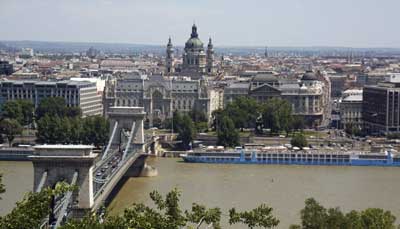
Budapest is also compact enough that budget travelers can stay in the cheap hotels and hostels a bit inland on the Pest side, and still walk everywhere while sightseeing. The Free Budapest Walking Tour covers highlights on both sides, and is a great introduction.
What to see and do in Budapest
During daylight hours, Budapest has the standard selection of monuments and museums in addition to its castle complex, but separates itself from other big cities with its abundant hot springs and spas. Tourists can easily mix with locals and take a dip at a modest fee in one of the unique facilities spread around town.
At night, however, Budapest really comes into its own, with some of the most interesting nightlife in Europe. Head for what are known as “ruin pubs” on the Pest side in the old Jewish Quarter to quaff cheap drinks in converted courtyards that each has its own weird vibe.
Krakow, Poland
2022 Backpacker Index: US$30.72/day
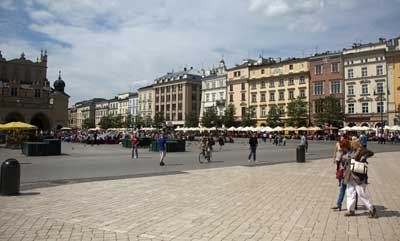
For those who like hearty portions of meats and sausages, Krakow is wonderful, but there are also many Italian and other international cuisines, including many vegetarian options, so something for everyone. Hotels just on or near the central square are reasonable, but you can stay for a lot less by going a few blocks away.
What to see and do in Krakow
As in many other cities, taking the Krakow Free Walking Tour is a great way to get oriented on your first day so you’ll know what you want to explore more deeply. You can also cover many of the main central sights on that tour, which leaves time for day trips and hanging out. Sad though it may be, a half-day trip to nearby Auschwitz is something you’ll never forget, and there is a fun salt mine attraction not far away as well.
In the evening you’ll probably find out why Krakow is very popular with the weekend party and stag-do crowds. You can sip affordable wine at one of the cafes on the square, but it might be more fun to do a pub crawl through the varied drinking establishments in the nearby Jewish Quarter. It’s easy to find a .5L beer for around US$1.50, so getting carried away is common.
Český Krumlov, Czech Republic
2022 Backpacker Index: US$40.47/day
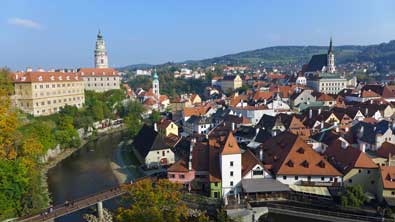
There are almost no chain hotels or restaurants of any kind, so staying here will be a very local experience. Better still, hotels and food here are much cheaper than even in Prague, so the value is outstanding. The historic town center is small enough to walk through in less than 10 minutes, yet you can still get nice hotels in its heart starting at around US$50 per night. As of 2022 the hostels in Český Krumlov are closed so we had to use hotels for the Backpackers Index, which makes the index price artificially higher than it should be. In other words, if you visit this town you’ll find it to be pleasantly affordable.
What to see and do in Český Krumlov
Český Krumlov does have an impressive castle perched above the compact town center, and you’ll definitely want to tour at least part of it. But really the main reason to visit the town is to slow down and appreciate being outside of Europe’s large cities for 2 or 3 days. Those other four cities are always busy and crowded, while this one is gentle and lovely, although you will be surrounded by quite a few other tourists.
As with the other cities on the list, there is a highly recommended free walking tour in Český Krumlov, which is a great place to start. That tour will also show you and explain all of the other worthwhile nearby sights, but I won’t blame you if you just prefer to grab a seat at one of the cheap restaurants with outdoor seating on the main square, and relax over a few delicious and inexpensive beers for a while.
Additional photo credits: Berlin by Philippe AMIOT on Flickr, Prague by POldi♬24 on Flickr

Hi Roger – truely excellent advice and this has really helped us try and plan our trip.
We are flying into Marrakesh on the 9th of Feb and out of Amsterdam on the 8th of March. We will be spending about 10-12 days in Morocco, but then need to make our way to Amsterdam. We definitely want to go to Barcelona, then a flight to Rome, but from here ate looking for recommendations for the rest of our travel. I like the idea of Prague but we’re generally pretty open. We have booked our last two nights accommodation in Amsterdam.
We are travelling with a toddler, who tends to travel well, so sleeper trains or flights would be preferable to long day trips. What would you suggest we see, and what can we safely give a miss?
Jasmine,
I’m glad you have found the information useful so far. It sounds like you’ve got about two weeks in between Morocco and Amsterdam. I recommend 3 nights in Barcelona and 3 or possibly 4 nights in Rome. That only leaves you 7 or 8 days after Rome and before Amsterdam. While you are in Italy it would be a shame to miss Florence for about 2 days and Venice for 1 day. They are all about two hours apart by train, and each is very different from the other. You’ll also have relatively good weather there compared to northern cities such as Prague.
With about 4 days after Venice and before Amsterdam, I’d go to Paris if I were you. Assuming you haven’t been to Europe before, Paris really does live up to the hype and it’s one of the most beautiful cities in the world. It’s also far easier to reach than Prague, as there are frequent cheap flights from Venice or nearby Treviso, or Milan. Prague is definitely a bit cheaper than Paris, but Paris can be done on a reasonable budget, and it’s worth the little splurge. The weather there should also be a bit nicer than Prague or Berlin.
Another nice thing about this itinerary is that Paris is only about 3 hours 15 minutes from Amsterdam by high speed train. So your toddler should be able to manage that, as opposed to many of the longer train trips you’d need if you went elsewhere.
Let me know if this sounds good to you and I can provide more details if you need them. Or if you had something else in mind, I can try again if you let me know what you are after. -Roger
Hello I will be travelling around end of February to Paris and I wanted a 1week short trip from Paris Zurich and Amsterdam . I was wondering in what order to make this trip. I will be landing in Paris and thereafter would like to visit the other two cities. It is my first visit to Europe and albeit a solo one. Can u please tell me the places to visit , esp near Zurich . I have tried doing research quite a bit but am confused . Also how should we travel and what about hotels. Are bnbs a good idea in Europe especially these 3 cities. Do u suggest any other tour I’m open to exploring new places . But am dead confused as to where to start . I searched other forums and various websites. This place has come close to helping me plan something but still I’m in a fix. It would be really helpful if u could give me an outline from where I can work upon. It’s a huge thing for me to be traveling alone and I don’t want to regret or miss out on places. Thanking u in advance .
Regards, monisha
Monisha,
I understand your confusion and I’ll be happy to help. First off, have a look at my article on where to go in Switzerland. It’s an amazing country, but Zurich itself is kind of a dud, and extremely expensive. As you’ll see in the article, I highly recommend 2 or 3 days in the Interlaken area and 1 or 2 days in the Lucerne area instead. If you are trying to do all of this in one week, then 2 nights in Interlaken is the best choice.
My standard recommendation is to spend 3 nights in almost any place you visit because if you stay only 1 or 2 nights you end up spending half of your time on trains and in train stations rather than seeing the things you’ve flown all that way to see. So if you could push this to 9 days it would be ideal, or 8 days would be far better than 7.
You’ll want at least 3 days in Paris. You could do Amsterdam in 2 days if you had to, and you could do Interlaken in 2 days if you had to. But again, that would only leave 4 real sightseeing days out of the 7, as your travel days will take most of your time, including checking in and out of hotels.
You’ll definitely want to get around by train. If you buy your train tickets online about two months early they will be fairly cheap. Buy from the official rail websites of the countries involved, such as the France Rail site, the Swiss Rail site, and the Dutch Rail site.
The accommodation known as a Bed and Breakfast is most popular in the UK, although you can find them in those cities as well. But generally they are listed among other hotels and guesthouses. Almost all hotels in these places will include breakfast, although it’s worth checking before you book. In Paris I highly recommend finding a hotel in the Rue Cler area, which is just east of the Eiffel Tower. In Amsterdam it’s probably best to find a hotel within walking distance of Centraal Station (the main train station) since you won’t be staying long. You can find my Switzerland hotel recommendations in that article.
Amsterdam to Paris is 3 hours and 18 minutes by train. From Paris to Interlaken it’s a bit over 5 hours. But from Amsterdam to Interlaken it’s a bit over 10 hours, so flying between Amsterdam and Zurich would be better and much cheaper as well. You can do them in any order.
I’m happy to help with more of the planning on your trip once you start making decisions. Feel free to ask more questions in future comments here and I’ll answer within a day. You are going to have a fantastic trip. -Roger
Hi Roger,
My family (kids will be 9, 13, and 15) and I are beginning to plan a trip to Europe next summer for two weeks. We will definitely see some extended family in Northern Italy for a few days and we were going to visit some friends in Northern Germany, but they would rather meet us in a “better” location. Vienna and Dubrovnik are two cities that sound great to visit. I really don’t want to spend a ton of time traveling, but maybe visiting 3 or 4 cities for 3 or 4 days. It is the early part of our planning, so any advice you can give is appreciated.
Bill,
There aren’t many highlights in northern Germany for most visitors, so if your relatives would prefer to spend time with you somewhere else, I think that might be a good idea. I have relatives in Germany and they’ve done the same thing many times. I’m not sure exactly what you are asking, but I will say that Vienna and Dubrovnik are both very nice, and also very different. Vienna is a crowded and “grand” city that was a capital of an Empire, while Dubrovnik, is famous for its tiny walled city overlooking the Adriatic. And Dubrovnik is reachable by a 10-hour or so ferry from Italy, so that could work. Vienna would be reached by train or perhaps plane from Italy.
My normal recommendation is to spend 3 days in each city you visit. If you go faster than that, you spend half your time on trains and checking in and out of hotels rather than seeing the sights you’ve gone all that way to see. I’m happy to help you plenty more with this, but I’ll need more comments and probably more of a specific question. Best of luck with this, and at least you’ve got plenty of time left to plan. -Roger
Hi Roger, We have made a few decisions. We are planning two weeks in the first part of July. We are going to spend the first week in Italy, starting out with extended family, who live north of Milan. Our friends in Germany will then meet us in Greece for the second week, since they have not been there yet. We are thinking that we will end our Italy adventure in Rome and fly to Athens, but is it better to take a boat? From where? So, we will have two families of 5 in Greece. Are there boating options to navigate Greece. How expensive? Any other advice?
Hey Roger,
My friend and I, Both 17 want to make a trip to Europe this summer. We are both from Hunterdon County, New Jersey. We are both really big into nature and small town feels. We would be able to go for about 2 weeks, and its not out first trip together, just first trip outside the country. We are both very able, and have the money to do so(but would like to keep it as cheap as possible). We love hostels and would be willing to backpack it all, it is just hard for us to set up an itinerary not knowing what is out there. We both love the looks of Norway, Belgium, Ireland, and Switzerland, but feel like we need to see the “usuals” like London and Paris. What would you suggest for our first trip?
Best regards,
Kyle Hensler
Kyle,
This is a tricky one. On one hand, I agree that cities like London, Paris, Berlin, and Amsterdam are the most interesting for a first trip to Europe, and in some ways they are the most fun as well because there are so many options and fellow travelers. My recommendation is generally to spend 3 days in nearly any place you visit, or even 4 days in the larger cities such as London or Paris. So if you are going for 2 weeks you could cover those 4 cities I mentioned and you’d have an amazing time.
Norway does have good nature sights, but it’s remote and incredibly expensive. Switzerland has even better sights when you include the dramatic places in and near the Alps such as Interlaken, and it’s also incredibly expensive. Belgium is pleasant although it’s flat as a pancake so it’s not as scenic as the others. Ireland is really wonderful once you get outside of Dublin. I’d save that for a future trip when you are ready to rent a car and spend a week or more driving between small towns and natural sights.
I discuss my thoughts on where to focus a first trip to Europe in that article. Have a look at that, and you might also be considering Italy, which is justifiably popular.
Let me know what you think about what I’ve mentioned so far, and I’ll be happy to add more advice once you have a focus in mind. -Roger
Hi Roger,
We’re thinking of visit Europe end of May 2017 for 12 days . We love nature and beautiful landscape. It’s our first visit to Europe . As we’re on budget and we plan not to spend more than 1500 Euro (mot including air ticket). We plan to visit Prague, Budapest, Krakow and Austria. Do you think this plan is doable ? Kindly advise.
Looking forward to hearing from you.
Cheng
Cheng,
Your plan could work, but each of those travel days would be fairly long. If you have only 12 days for a Europe visit, I recommend choosing exactly 4 cities. That way you have two full sightseeing days in each city, and one transit day in between. So assuming you mean Vienna when you say “Austria”, you will be in good shape. The trains in that part of Europe go kind of slow, so those journeys will all be 5 hours or more, with one or two of them closer to 9 hours. As long as you don’t mind longer train journeys like that, then your selection of cities is ideal for an affordable trip. But if you prefer shorter train journeys, you might drop Budapest or Krakow and substitute them with something else less remote to the others. Let me know if you have any questions. -Roger
Hi Roger,
Your comments have been really helpful as I start to plan my trip to Europe next year May. Time isn’t an issue for me, but budget is. I hope to spend max $3500 euros including airfare (from Chicago). I must visit either Frankfurt or London. The other countries and cities that have always stood out to me are Turkey, Greece, Italy, Croatia, Paris, Spain,and Ireland. I would be backpacking with a friend. It’s my first time in Europe and hoping to make the most of it. Any other must see rural areas or cities? Possible itineraries? Any tips would be greatly appreciated. Thanks!
M.J.,
I’m happy to hear that this information has helped. Most of the places on your list are fairly expensive, except for Turkey and Greece. As mentioned in the article above, I think the best value cities are Krakow and Budapest, and you can spend 2 or 3 days in each of them for the same price as one day in Italy or Spain, for example.
To make your budget stretch the longest, plan on 3 nights in your must-see expensive cities, and then you can linger much longer in eastern and central Europe. But on your first Europe trip, there’s no point in going to cheap places that don’t have many interesting sights, such as Belgrade or Sofia. If you have more specific questions I’ll be happy to help you with them. As far as more affordable and pleasant rural areas, Croatia is good. Turkey is another good one, but focus more on the touristy places such as Cappadocia, rather than the small towns with no famous sights because almost no one will speak English in places with few tourists. -Roger
Hi Roger,
Great to see some fantastic info shared here. We have two boys of 12 years and 5 years and are planning to visit Europe in month of April (end). I want to cover Paris, Brussels (hope to see Bruges too), Amsterdam, Berlin and Swiss. What itinerary would you recommend for a 10 days trip. Should I pick a Eurail pass. Or should I drop Berlin or Swiss because of the cost factors. Trying my best to be economical.
Regards,
Raju,
Your main challenge will be the amount of places you can visit in 10 days. I’d recommend no more than 4 cities, and even that will be rushed. My recommended minimum stays in those cities is Paris – 3 nights, Amsterdam 2 nights (but 3 is better), Berlin 3 nights, Bruges 2 nights, Brussels – see it as a day trip on your way to Bruges.
So what I’d recommend is Paris for 3 nights, then take a train to Brussels and see the city center for a few hours, then a train to Bruges for 2 nights. Then take a train to Amsterdam and stay for 2 nights, and then a train to Berlin for 3 nights. Switzerland takes at least 3 days to do properly, and it’s insanely expensive so better to leave it for a future trip.
Berlin is actually the cheapest city on your list, so no need to cut it out for budget reasons. But it is a longer train ride from the others, so you might consider saving it for a future trip as well. The main thing to understand is that when you go from one city to another, it will take most of that day including checking out of your hotel and getting to the train station and getting checked into your new hotel. So if you change cities every day, you end up spending more time on trains than you do seeing the places you’ve flown all that way to see.
For a trip like this a Eurail Pass will not be good value. You are best off buying the tickets online about 2 or 3 months in advance. They will be fairly cheap if you buy that early. Let me know if you have any other questions. -Roger
Hi Roger,
Very helpful article. I’ve just been told I need to take a four-six week holiday from work (unlucky me) sooner than later and want to start (quickly) planning such a trip in Europe. It’d just be me and my partner and we’ve never been. To push me into the right direction, are there places you recommend to go to or avoid in October/November? Does it start getting too cold/quiet in some places? Are hire cars a viable option of travel?
Thank you in advance.
Andrew,
Lucky you. For me, October and November are great times to visit Europe, because the weather is still decent yet the crowds are mostly gone. It can get cold in November up north, but in Italy, Spain, and southern France it’s still pretty nice.
The only real places to avoid that time of year would be beach towns where most of the hotels are only open 4 to 6 months a year. So forget Ibiza or the Costa del Sol in Spain, and also you’ll want to avoid any of the Greek islands that time of year. Aside from that, all the cities are crowded with locals and buzzing with festivals and so forth.
It would probably be best to start in the north and head south as November approaches. So you could do Amsterdam and Berlin and Prague and that area first, and then head south to France and Italy and Spain later on. I’ll be happy to give you some suggestions once you let me know the sorts of things that interest you and how long you want to stay in them. But overall, you are in great shape with the choices you have ahead of you.
Oh, and the trains are almost always the best way to get around in Europe. Hiring a car can be good to tour wine regions or national parks and some small towns, but to go from city to city a car will be far more complicated because parking in the cities is challenging and expensive. I’m happy to help you sort out train info as well. -Roger
Hi Roger,
My wife and I are planning our first Euro trip for this upcoming spring. We are planning to go from march 3-20.
We enjoy sight seeing and tourist attractions but don’t enjoy bigger cities too much. Therefore, seeing the countryside of places would be ideal for us. We have about $6,000 for the 18 day trip, not including flights. We believe flying into London and flying out of Dublin would be the cheapest flight plan to get to and from the US.
Any advice you can give us on traveling (by train, bus, or local flights) would be very helpful. Also, what is your take on renting vehicles to drive out to the countrysides. Do you recommend it or is it cheaper taking public transportation?
We are still working on how many days we’ll be staying in each country. Also, we are aware that the list consists of many countries and therefore, are willing to cut on some of them. Your advice on which countries and cities are a must see would be greatly appreciated!
This is our list:
Top 4 countries-
England: London
Ireland: Dublin
Spain: Barcelona, Madrid, Aviles (It’s my last name)
Italy: Rome, Venice
Other considerations-
Netherlands: Amsterdam
Belgium: Brussels, Bruges
Germany: Berlin, Wusterhausen (Wife’s maiden name)
France: Paris
Switzerland: Interlaken
Scotland: Glasgow
Denmark: Copenhagen
We look forward to hearing from you, and we appreciate your help.
Thanks!
Alvin,
This will be a fantastic trip and I’m happy to help you sort out an itinerary. Let’s start out looking at your schedule. If you have 17 days you really only have time for 5 or maybe 6 cities. As I’ve said so many times before, it’s best to schedule 3 nights in most places, or even 4 nights in the largest cities such as London or Paris. So unless you can add more days, let’s figure on 6 total destinations. If you try to move faster than that you’ll end up spending half of your time on trains and in train stations, and you’ll only have time for a superficial visit to each place.
London (where I’m based at the moment) is an ideal place to start, and you’ll need at least 3 nights. Dublin is actually kind of a dud compared to most famous European cities, but the countryside and smaller towns of Ireland are amazing, so that should be more of your focus, especially since you say you prefer countryside to cities.
If you wanted to visit Spain you’d need 3 nights in Barcelona and 3 nights in Madrid, and it would be best to fly in and out and take the high-speed train between those cities. If you wanted to add Aviles it would require another flight or a 7+-hour train ride each way.
The fastest tour of Italy that I recommend is one night in Venice, two nights in Florence, and 3 nights in Rome. The cities are connected by high-speed trains of about 90 minutes each, so it’s simple enough to see all three cities that quickly.
While it’s not on your main list, I’ll highly recommend Paris for 3 nights. It’s only 2 hours from London by Eurostar train, and it is a stunning and fascinating place. Paris is perhaps the number one highlight of most Europe trips, so I’d consider it if I were you.
Amsterdam is also a stunning place, and you could see it in as few as 2 nights if you were really hustling, plus it’s only about 3 hours from Paris by train. I really don’t think you’ll have time for any of the others on your list on this trip.
Renting cars in Europe can be great for touring countrysides and wine regions and that sort of thing, but it’s unwise to rent cars to go between large cities. Your list is mostly cities rather than countrysides, so I’d focus on trains and maybe a few flights.
With all of this in mind, your next step will be to figure out which destinations are the real priorities to fit into your 17 days. Once you have your list pared down to around 6 stops, it will be easy to see how to get between them, and I’ll be happy to help. -Roger
Hi Roger
After going through your posts and searching on web,here is my list:-
1.Paris 3 nights
2.Brussels and Brugges 3 nights
3.Amsterdam 3 nights
4.Berlin/Munich whatever you suggests 3 nights
5.Prague 3 nights
6.Vienna 3 nights
7.Poland 3 nights
8.Switzerland 3 nights
Now,it’s 7-8 places in 25 days.Hope this works well and is doable itinerary.
Kindly advice.
Thanks
Harsh
Harsh,
Yes, this looks great and filled with highlights. In Poland you are going to want to focus on Krakow, which is by far the best tourist city and also the easiest to reach. In Switzerland you’ll want to focus on Interlaken, and perhaps Lucerne for one day. I’m sure this will be an excellent trip. -Roger